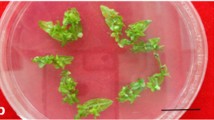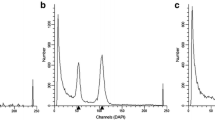Abstract
A protocol for in vitro induction of crape myrtle tetraploids using nodes from in vitro-grown shoots (2n = 48) was established. Nodal buds were excised from in vitro-grown shoots, maintained on proliferation medium containing Murashige and Skoog medium supplemented with 4.44 μM 6-benzyladenine , 0.54 μM α-naphthaleneacetic acid, and treated with a range of concentrations of colchicine under three different conditions. Nodal bud explants treated in liquid proliferation medium supplemented with either 15 or 20 mM colchicine for 24 h turned necrotic and died; whereas, those cultured on solid proliferation medium supplemented with either 125 or 250 μM colchicine for 30 days survived, but no tetraploid plants were obtained. However, when explants were cultured in liquid proliferation medium containing 250, 500 or 750 μM colchicine for 10 days, tetraploid plants (2n = 96) were obtained. Incubation of explants in medium containing 750 μM colchicine promoted the highest frequency of survival (40%) of explants and of recovered tetraploids (60%). Morphological and anatomical characteristics of leaves, including leaf index, stomata size and number, stomata index (length/width), and number of chloroplasts in guard cells correlated with ploidy of crape myrtle plants. The number of chloroplasts in guard cells of stomata was a stable and reliable marker in discriminating plants of different ploidy levels. Chromosome counts and flow cytometry confirmed these findings.



Similar content being viewed by others
Abbreviations
- BA:
-
6-Benzyladenine
- NAA:
-
α-Naphthaleneacetic acid
- MS:
-
Murashige and Skoog (1962) medium
- DMSO:
-
Dimethyl sulfoxide
References
Ali R (1977) Chromosome numbers in some species of Lagerstroemia. Curr Sci 46(16):579–580
Brykczynski J (1960) Efficient production of triploids in sugar beet. Euphytica 9(2):196–198
Carvalho JFR, Carvalho CR, Otoni WC (2005) In vitro induction of polyploidy in annatto (Bixa orellana). Plant Cell Tissue Organ Cult 80:69–75
Chakraborti SP, Vijayan K, Roy BN, Qadri SMH (1998) In vitro induction of tetraploidy in mulberry (Morus alba L.). Plant Cell Rep 17:799–803
Compton ME, Gray DJ, Elmstrom GW (1996) Identification of tetraploid regenerants from cotyledons of diploid watermelon cultured in vitro. Euphytica 87:165–172
Doležel J, Binarová P, Lcretti S (1989) Analysis of nuclear DNA content in plant cells by flow cytometry. Biol Plant 31(2):113–120
Dwivedi NK, Sikdar AK, Dandin SB, Sastri CR, Jolly MS (1986) Induced tetraploidy in mulberry I. Morphological, anatomical and cytological investigations in cultivar RFS-135. Cytologia 51:393–401
Egolf DR, Andrick AO (1978) The Lagerstroemia handbook-checklist: a guide to crapemyrtle cultivars. Am Assoc of Botanical Gardens and Arboreta, Inc. 72 pp
Eymar E, Alegre J, Toribio M, Lopez-Vela D (2000) Effect of activated charcoal and 6-benzyladenine on in vitro nitrogen uptake by Lagerstroemia indica. Plant Cell Tissue Organ Cult 63:57–65
Fare DC, Gilliam CH, Ponder HG, Griffey WA, Burgess HE (1985) Crapemyrtle: promising new selections for southern landscapes. Highlights agricultural research. Alabama agricultural experiment station 32(3):4
Grigoriadou K, Leventakis N (2003) Comparative use of a commercial bioreactor system and conventional micropropagation for the production of potato microtubers and grape myrtle (Lagerstroemia indica) microshoots. Acta Hortic 616:369–373 International Society for Horticultural Science (ISHS)
Hilu KW (1993) Polyploidy and the evolution of domesticated plants. Am J Bot 80(2):1491–1499
Knox GW, Norcini JG (1992) Lagerstroemia cultivars under evaluation at the NFREC-Monticello. Florida State Horti Soc, Meeting (USA) 104:346–347
Lakshmanan P, Lee CL, Goh CJ (1997) An efficient in vitro method for mass propagation of a woody ornamental Ixora coccinea L. Plant Cell Rep 16:572–577
Lee BC, Lee SK, Kim JH (1987) In vitro mass-propagation of Lagerstroemia indica f. alba Rehder. Research Report of the Institute of Forest Genetics, Korea Repub 23, pp 128–131
Margaret P (2006) Crapemyrtle. In: Anderson NO (ed) Flower breeding and genetics: issues, challenges and opportunities for the 21st century. Springer, Netherlands, pp 439–457
Maynard DN, Elmstrom GW (1992) Triploid watermelon production practices and varieties vol (318). ISHS Acta Hortic: II international symposium on specialty and exotic vegetable crops. pp 163–178
Murashigue T, Skoog F (1962) A revised medium for rapid growth and bioassays with tobacco tissue cultures. Physiol Plant 15:473–497
Niranjan MH, Sudarshana MS (2005) In vitro response of encapsulated somatic embryos of Lagerstroemia indica L. Indian J Exp Biol 43(6):552–554
Rose JB, Kubba J, Tobutt KR (2000) Induction of tetraploidy in Buddleia globosa. Plant Cell Tissue Organ Cult 63(2):121–125
Roy AT, Leggett G, Koutoulis A (2001) In vitro tetraploid induction and generation of tetraploids from mixoploid sin hop (Humulus lupulus L.). Plant Cell Rep 20(6):489–495
Sarreb DA, Ładyzy’nski M, Malepszy S (2002) Comparison of triploid and diploid cucumber in long-term liquid cultures. Plant Cell Tissue Organ Cult 71:231–235
Shao JZ, Cl Chen, Deng XX (2003) In vitro induction of tetraploid in pomegranate (Punica granatum). Plant Cell Tissue Organ Cult 75:241–246
Thao NTP, Ureshino K, Miyajima I, Ozaki Y, Okubo H (2003) Induction of tetraploids in ornamental Alocasia through colchicine and oryzalin treatments. Plant Cell Tissue and Organ Cult 72(1):19–25
Tong J, Ye YM, Feng B, Yuan W (2009) Colchicine induced polyploid plants and their identification in three species of Lagerstroemia indica. Acta Hortic Sinica 36(1):127–132
Väinölä A (2000) Polyploidization and early screening of Rhododendron hybrids. Euphytica 112:239–244
Wu JH, Mooney P (2002) Autotetraploid tangor plant regeneration from in vitro Citrus somatic embyogenic callus treated with colchicine. Plant Cell Tissue Organ Cult 70:99–104
Yamamoto T, Uhara T, Takemasa K, Shimizu Y, Matsumoto A (1995). Micropropagation of crape myrtle (Lagerstroemia indica L.) vol (44). International plant propagators’ society: combined proceedings 1994, publ. pp 254–258
Yang XM, Cao ZY, An LZ, Wang YM, Fang XW (2006) In vitro tetraploid induction via colchicine treatment from diploid somatic embryos in grapevine (Vitis vinifera L.). Euphytica 152:217–224
Zhang LY, Guo QG, Li XL, Zeng H, Tan JM, Liang GL (2005) Study on the relationship between the number of chloroplast in stomata guard cell and the ploidy of loguat cultivars. J Fruit Sci 22(3):229–233
Zhang ZH, Dai HY, Xiao M, Liu X (2008) In vitro induction of tetraploids in Phlox subulata L. Euphytica 159:59–65
Zhao FC, Nilanthi D, Yang YS, Wu H (2006) Anther culture and haploid plant regeneration in purple coneflower (Echinacea purpurea L.). Plant Cell Tissue Organ Cult 86(1):55–62
Zhu ZT, Zhang ZY (1997) The Status and Advances of Genetic Improvement of Populus tomentosa Carr. J Beijing Forest Univ (English Ed.) 6(1):1–7
Acknowledgments
This research was financially supported by The Science Foundation of College of Jinling Institute of Technology, China (JIT-RCYJ-2007001). We greatly appreciate Dr. Aliya Momotaz, Plant Geneticists, PFVRC, Wisconsin and Dr. Jiehua Wang for critically reviewing the manuscript and their useful comments.
Author information
Authors and Affiliations
Corresponding author
Rights and permissions
About this article
Cite this article
Zhang, Q., Luo, F., Liu, L. et al. In vitro induction of tetraploids in crape myrtle (Lagerstroemia indica L.). Plant Cell Tiss Organ Cult 101, 41–47 (2010). https://doi.org/10.1007/s11240-009-9660-5
Received:
Accepted:
Published:
Issue Date:
DOI: https://doi.org/10.1007/s11240-009-9660-5




